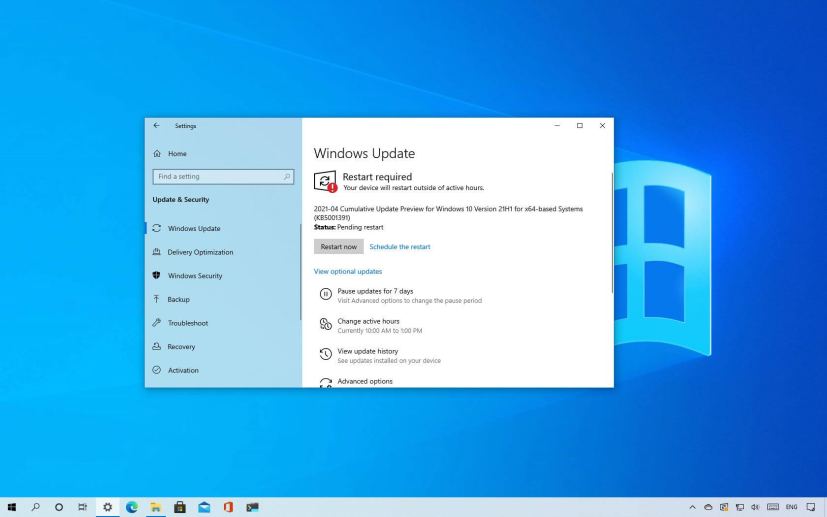- Microsoft releases Windows 10 build 19043.962 in the Beta and Release Preview Channels.
- The update KB5001391 includes the “news and interests” taskbar widget.
- This release improves Windows Mixed Reality and Windows Server Storage Migration Service.
- Build 19043.962 delivers a slew of fixes for Start, Edge, memory and high processor usage, and more.
As part of the Windows 10 21H1, Microsoft is now rolling out build 19043.962 as update KB5001391 for devices enrolled in the Beta Channel of the Windows Insider Program. The update is also available in the Release Preview Channel, but for computers that meet the commercial device’s criteria.
The update KB5001391, according to the company, brings a slew of fixes and improvements. For instance, in this release, Windows 10 is incorporating the “news and interests” widget in the taskbar, which was previously planned for version 21H2, and it is improving the Windows Server Storage Migration Service. The update also fixes problems with Microsoft Edge, Start menu, language, memory usage, high processor usage, dual graphics cards, system issues, and several issues for devices connected to a domain.
What’s new with Windows 10 builds 19043.962
Here’s a complete list of everything included with the latest update for version 21H1.
Added new features and changes:
- Microsoft is rolling out news and interests on the Windows taskbar to the Beta and Release Preview Channels. News and interests on the taskbar make it easy to stay up to date with information at a glance.
- Added the ability to adjust the amount of idle time before a headset goes to sleep in the Settings app for Windows Mixed Reality.
- Windows Server Storage Migration Service improvements include new support for migration from NetApp FAS arrays to Windows Servers and clusters, and it resolves multiple issues and improving reliability.
Added fixes and improvements:
- Fixed an issue that prevents a site from transitioning out of Microsoft Edge IE Mode when expected.
- Addressed a problem that fails to remove mandatory profiles completely when you sign out when using the “Delete cached copies of roaming profiles” Group Policy.
- Fixed an issue that causes blank tiles to appear on the Start menu with names such as “ms-resource:AppName” or “ms-resource:appDisplayName.”
- Addressed a problem with the Microsoft Japanese Input Method Editor (IME) that prevents an app’s custom candidate window from displaying correctly.
- Fixed an issue that occurs when you install inventory applications.
- Addressed a problem that includes kernel-mode rules for .NET applications in Windows Defender Application Control policies. As a result, the generated policies are significantly larger than necessary.
- Fixed an issue that causes devices to fail Device Health Attestation.
- Addressed a problem that turns off S Mode when you enable System Guard Secure Launch on a system running Windows 10 in S Mode.
- Fixed an issue that causes “lsass.exe” memory usage to grow until the system becomes unusable.
- Addressed a problem with a race condition between Task Scheduler and the Workstation Service.
- Fixed an issue that causes Azure Active Directory authentication to fail after signing in on Windows Virtual Desktop machines.
- Addressed a problem that causes AAD Work Accounts to unexpectedly disappear from certain apps such as Microsoft Teams or Microsoft Office.
- Fixed an issue with a partial Service Connection Point (SCP) configuration that causes dsregcmd.exe to stop working.
- Addressed a problem that accidentally triggers hybrid AAD joining when the Group Policy “Register domain-joined computers as devices” is set to DISABLED.
- Fixed an issue that might generate a stop error when Docker containers run with process isolation.
- Addressed a problem that causes automatic enrollment and certificate retrieval to fail with the error, “The parameter is incorrect.”
- Fixed an issue that might cause Microsoft Defender Application Guard virtual machines to stop responding when Microsoft Defender Application Guard for Office opens a document.
- Addressed a problem that prevents some media players from playing content on hybrid devices that are running with dGPU on iGPU displays.
- Fixed an issue with race conditions that cause high CPU usage.
- Addressed a problem with a deadlock in the New Technology File System (NTFS).
- Fixed an issue that causes DWM.exe to stop working in some cases.
- Addressed a problem that might prevent an application screen from working when using a Remote Desktop ActiveX control that is embedded in an HTML page.
Install Windows 10 21H1
If the device running version 20H2 is not enrolled in the Windows Insider Program, you first need to enroll it in the Beta Channel before you can download the update. You can do this by going to Settings > Update & Security > Windows Insider Program and clicking the Get started button.
In the wizard, click the Link an account option, select your Microsoft account, and click the Continue button. Under the “Pick your Insider settings” section, select the Beta Channel option, and click the Confirm button. Confirm the terms and conditions, restart the device, and then use the following steps to upgrade.
Then you can install Windows 10 21H1 going to Settings > Update & Security > Windows Update, click the Check for updates button, and then under the “Feature update to Windows 10, version 21H1” section, click the Download and install option.

